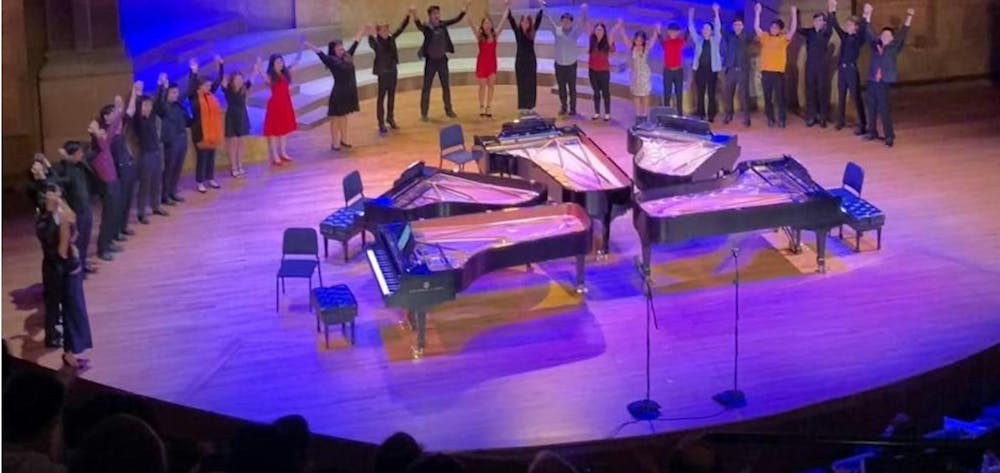Under golden lights, the crisp opening notes of “I See the Light” reverberate in a full Richardson Auditorium — starting from one piano, and ending with five concert grand Steinways. For the next hour and a half, the Princeton Pianists Ensemble (PPE) enraptured, entertained, and elated both classical and pop fanatics in the audience with music from Mozart to Super Mario Bros.
As one of the few student-run music groups independent from the Princeton Music Department, PPE exhibited its multifaceted repertoire in its eleventh concert season on the evening of Nov. 17, which consisted of original student arrangements.
The pianists emerged onto the stage in concert black, blending in with the monochrome pianos. Disney’s “I See the Light” and Shostakovich’s “Suite for Jazz Orchestra No. 2 - VI. Waltz No. 2” began with a single melody rising from the hushed silence, leaning into the clichés of a classical beginning. As an increasing number of nimble hands danced in unison, dynamics grew, tempo increased, and chords thickened into a polyphonic climax. In the third piece, the twists began.
During the popular ballad of “Golden Hour” by JVKE, the pianists were at the peak of the soaring chorus when Kalu Obasi ’25 jumped up from his piano, slid his neighboring pianist off the bench, and launched into a brief whimsical detour of flowery chords and arpeggios.
The stage glowed vibrant shades of red, yellow, and blue as five students returned, each adorned with a Super Mario Bros. headpiece. The upbeat theme transformed the stage into a video game, and at the finale, Obasi (now with a red Mario hat) brought a melodica behind the piano and began playing the staccato main tune.
PPE’s never-let-them-know-your-next-move arc continued in the second half of the concert after a mid-act by the a capella group Roaring 20s. During the flying theme from “E.T.,” pianist Amy Liu ’26 casually stood up and plucked on the inner strings of the Steinway, with all the correct notes (Easier said than done, if you’ve ever tried telling the inner strings apart).
For the next piece, Kellen Cao ’26 and graduate student Anthony Coniglio combined Debussy’s “La fille aux cheveux de lin” — a lighthearted French prelude that translates to “girl with the flaxen-colored hair” — and “Minstrels,” which portrays devious court jesters vying for the king’s attention. Debussy’s more well-known Impressionistic music is embodied in the first piece with flowing chords and arpeggios. Meanwhile, the medley tells the story of the jesters attempting to capture the attention of the girl with flaxen hair. At one point in “La fille aux cheveux de lin,” Cao whipped out a jester hat and began the humorous disruption of the Minstrels’ theme. With tambourine tangents, Hi-Chew (a Japanese fruit candy) tosses, and dances around the stage perfectly synchronized to the rhythm, the five pianists played and acted the parts of jesters. The audience, perhaps playing the part of the flaxen-haired girl, filled the auditorium with laughter.
Amusement turned to awe with the Allegro movement of Mozart’s “Concerto for 3 Pianos and Orchestra in F Major,” which was rearranged for four pianos. Mozart’s fresh, festive exuberance shone through the seamless transitions between major and minor modes from one piano to the next.
As the last work on the program, the stage lights switched from an ominous mix of tangerine and maroon for “Lord of the Rings” to a pastel palette of azure, lilac, gold, and pink for “How to Train Your Dragon.” The program describes the sagas as portraying the exhilaration of flight and bravery, with “the technically demanding runs aim[ing] to underscore the depth and emotive resonance within the grandeur of these beloved fantasy realms.”
PPE incorporated one final surprise for the standing ovation, rushing into a “La La Land” medley for the encore piece. While two pianists switched sides at each piano, the others danced in the background.
The holographic lighting mirrored the constantly changing, fleeting short piano compositions, just like an aurora. In those brief moments, the musicians’ hard work came to fruition, resonating as vivid flashes in each listener’s memory.
Chloe Lau is a contributing Prospect writer and contributing Features writer for the ‘Prince.’ She can be reached at chloelau@princeton.edu









